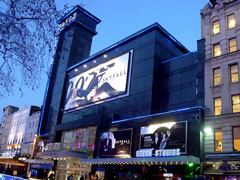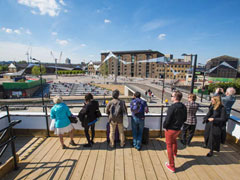


Once upon a time before the 19th century, Leicester Square was a little like today’s Chelsea, patronised only by the wealthy. But then as happens in big cities all this changed, with the aristos moving out and the area falling into neglect until theatres starting popping up, transforming this into the hub of London’s new entertainment district.
Unlike nowadays when the theatre is a highbrow form of entertainment and performers are given the highest form of respect, in the times of Samuel Pepys and beyond it was quite the opposite. Plays were often vulgar and aimed at horny men; women rarely visited the theatre and those who did were considered cheap. By the 1800s this had changed, and a visit to the theatre was an altogether more wholesome experience, however as we shall see that’s not to say Theatreland didn’t continue to be salacious.
The cinemas on Leicester Square are now the scene of major film premieres, where people queue up for hours for the chance to get a glimpse, and in some lucky cases an autograph of a Hollywood star. But most of these cinemas began life as theatres. The exception is the Odeon Leicester Square, which began its first incarnation as the Royal Panopticon of Science and Art when it opened in 1854. Its purpose was to host exhibitions and lectures on art and sciences, and despite initially attracting a thousand visitors a day it closed within two years, making its founder bankrupt. After this a circus ring was added to the building and it re-opened as the Alhambra Palace, so-called because of its Moorish-inspired architecture, like the building of the same name in southern Spain. Among the Alhambra’s entertainment was the can-can, and other dances performed by young girls; unsurprisingly the audience for these was mostly made up of men. During the interval, which was of considerable length, the dancers would head to the basement bar to mingle with them; they would drink and flirt till it was time to go back on stage. Many would agree to rendez-vous again after the show, and it wouldn’t be for a game of chess, and it wouldn’t be for free either.
\n\nIn 1882 the Alhambra was destroyed in a fire. It was rebuilt within a year and continued to function as a theatre until in 1936 it was decided it should be demolished. The following year the Odeon opened, a large, brand spanking new cinema with a stage.
The Empire, another of Leicester Square’s cinemas, had a rather more conventional start as a theatre and music hall. It first opened in 1884 with a capacity for 3000 people and a programme that included vaudeville and burlesque, but that’s about as salacious as it got. Unlike many other places of entertainment it thrived throughout World War II, with Gone With the Wind the most popular movie.
Leicester Square’s second Odeon, the smaller Odeon West End, was initially intended to be used for live performances, but as it turned out the land purchased was smaller than what was needed. Having opened as the Leicester Square Theatre in 1930, it was used mainly as a cinema, but it struggled to keep afloat despite showing films continuously from midday to midnight from Monday to Saturday. This meant the theatre could attract shoppers, tourists, passing trade and anyone who’d stayed up all night or was at the start of a night of debauchery. Over the years there were many takeovers, and the building suffered bomb damage during WWII. Plans to tear it down and erect a hotel in its place were abandoned in 2010, but a new proposal by the owners of the Radisson hotel chain has been accepted much to the dismay of English Heritage and many others, as it means the loss of a historical building and the possible disturbance to neighbours like the National Gallery.
\n\nThe Vue cinema launched as Daley’s Theatre in 1891, founded by American theatre producer Augustin Daley. On its opening night it showed a performance of Shakespeare’s The Taming of the Shrew; movies were not shown until after it was torn by new owners the Warner Brothers in 1937. In its place they built a cinema and theatre complex, calling it simply the Warner Theatre. This was in turn demolished in the 1980s to make way for a new nine-screen cinema, still owned by Warner. It was bought by Vue in 2003.
The Prince Charles Cinema has been an art house and repertory cinema since 1991, but before that it was a West End theatre that wasn’t particularly successful. Opened in 1961, managers tried poetry readings and music to boost ticket sales, but this didn’t work either. It then became a more lucrative adult cinema, and acquired the title of having the longest UK runs of Caligula and Emmanuelle. But it’s been most successful since being taken over by an independent company to provide cheaper seats than at other cinemas – the Prince Charles can boast of being the only truly independent, non-subsidised repertory cinema in the UK. Unlike other venues their programming has earned them a loyal following and they can count film director Quentin Tarantino as a fan, who upon release of Kill Bill said: “The day that Kill Bill plays at the Prince Charles Cinema is the day that it truly comes home.”


